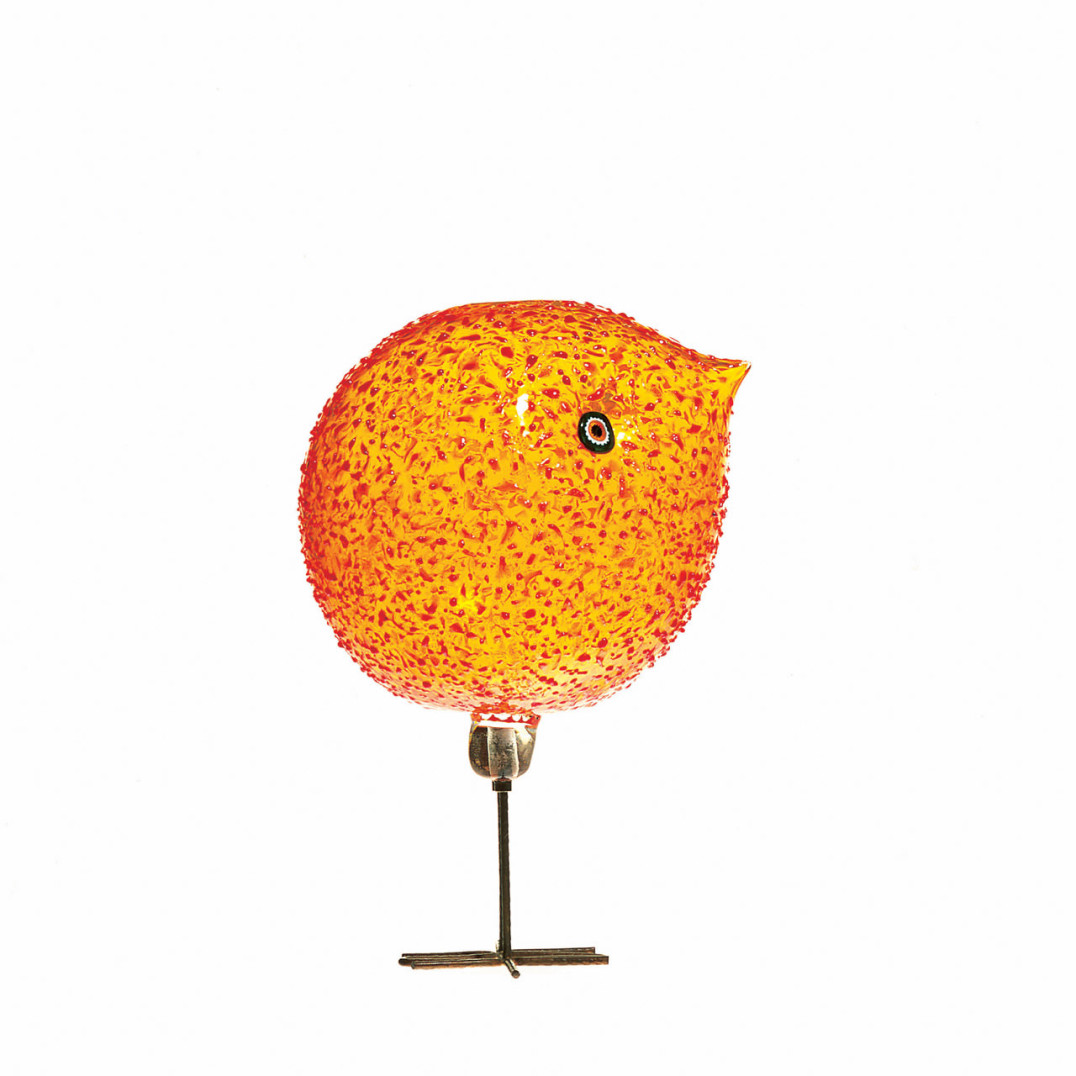
Alessandro PianonPulcino, 1960-1961
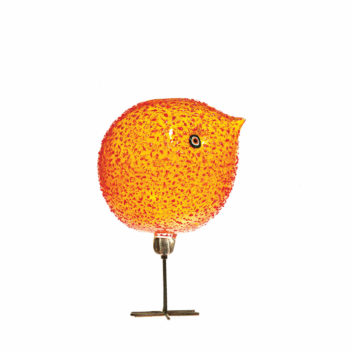
Alessandro PianonPulcinoVetreria Vistosi, 1960-1961
Pulcino made of orange trasparente glass, decorated with granzeoli made of glass grit. Feet crafted
in copper.
8 1/4 in. high (22.2 cm)
Exhibitions:
2000, New York, Venetian Glass, Museum of Arts & Design;
2001, Milan, Murano: Vetri dalla Collezione Olnick Spanu, Spazio Oberdan.
Bibliography and comparative texts:
Domus, 1962, April;
B. Nerozzi, 1987, nn. 130-133;
M. Heiremans, 1989, nn. 230, 231;
M. Karasik, 1989, n. 36;
R. Barovier Mentasti, 1992, n. 119;
M. Heiremans, 1993, n. 249;
F. Deboni, 1996, n. 243;
M. Heiremans, 1996, nn. 209, 211, 212;
M. Barovier, 1996, n. 103;
M. Barovier, 1999, p. 275;
Olnick Spanu, 2000, n. 143;
Olnick Spanu, 2001, n. 180.
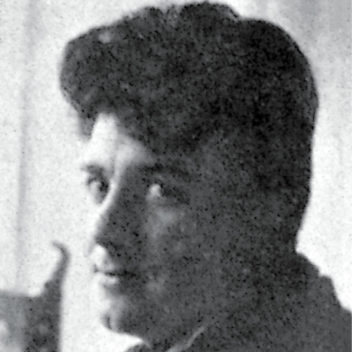
Alessandro Pianon 1931–1984
Born in Venice, Alessandro Pianon attended the Architecture School in Venice and used his talents to become an architect and designer. He was hired by the Vetreria Vistosi in 1956 to design the company logo and ended up designing numerous collections of glass. In 1962 he started his own design studio and worked for many companies, including Lumenform.
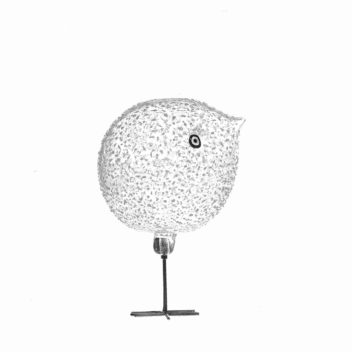
Vetreria Vistosi 1945–1990
The descendant of a family who had been Murano glassmakers for hundreds of years, Guglielmo Vistosi opened the Vistosi furnace in 1945 to produce glass components for lighting. After his death in 1952, the direction of the company was taken over by his brother Oreste and his nephews Gino and Luciano. They carried on the line of production, serving as designers as well. Vistosi also sought the collaboration of many independent artists and professionals such as Alessandro Pianon, Peter Pelzel, and Fulvio Bianconi. During the '60s, the company, successful for its essential forms and the sobriety of its colors, received many awards. During the following decade, its pieces were designed by Angelo Mangiarotti, Enrico Capuzzo, Gae Aulenti, Vico Magistretti, Elenore Peduzzi Riva, and Ettore Sottsass Jr. After the company's change of ownership, the furnace produced glass components for lighting until it was closed in the early '90s.
Alessandro PianonPulcino, 1960-1961
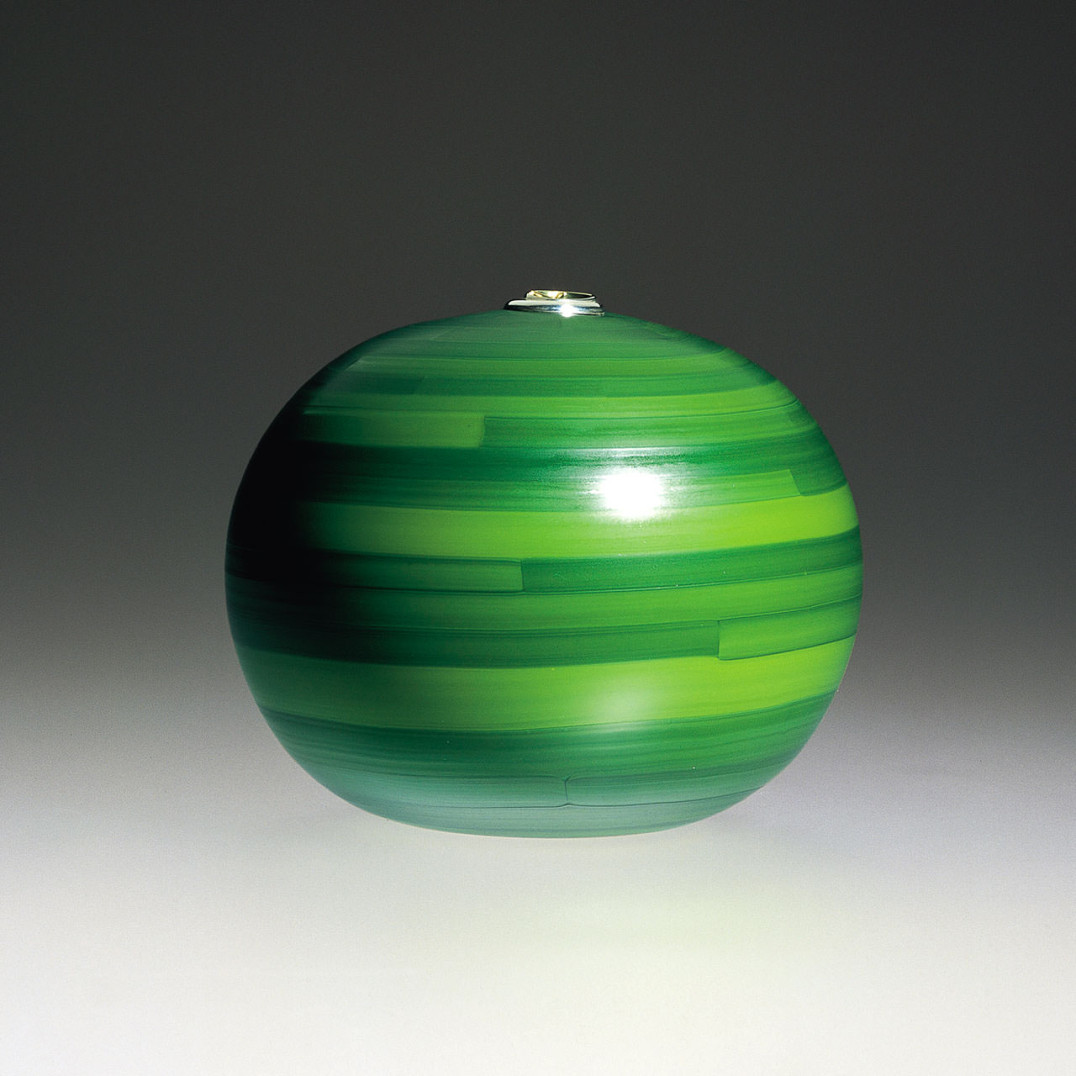
Thomas StearnsIl vaso per le lacrime del Doge, 1961
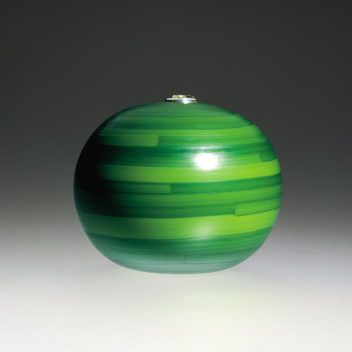
Thomas StearnsIl vaso per le lacrime del DogeVenini & C., 1961
Green orb composed of horizontal green glass canes with an inlay of silver and gold at the aperture.
A prototype, never produced,
Engraved: Stearns per Venini 61 Il vaso per le lacrime del Doge Orbe verde.
Hand written label: Stearns Venini 61 – Vessel for The Doges Tears.
5 1/2 in. high (14 cm)
Exhibitions:
2000, New York, Venetian Glass, Museum of Arts & Design;
2001, Milan, Murano: Vetri dalla Collezione Olnick Spanu, Spazio Oberdan.
Bibliography and comparative texts:
Olnick Spanu, 2000, n. 142;
Olnick Spanu, 2001, n. 179.
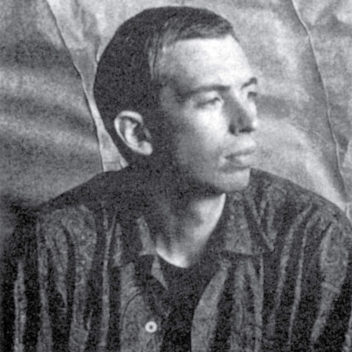
Thomas Stearns 1936–2006
Thomas Stearns was born in the United States on September 4, 1936, in Oklahoma City. From 1955 to 1957, he left his hometown to study painting at the Memphis Academy of Art. Between 1957 and 1959 he attended the prestigious Cranbrook Academy of Art and received a postgraduate Fulbright Travel Grant for Italy. He was 24 years old when he arrived at Venini. He started working after Christmas 1959 and stayed with the firm all of 1960 as well as 1961. He left Venice at the end of November 1962, and shortly thereafter the Victoria & Albert Museum in London ordered a group of his works produced by Venini. In 1964, he had his first exhibition of sculpture at the Willard Gallery in New York. In 1965, he was awarded a Guggenheim Fellowship for Sculpture and a grant from the National Institute of Arts and Letters. In 1968, he had a one-man show called Constructions at the Ringling Museum of Art in Sarasota, Florida. In 1970, Stearns began teaching at the University of the Arts, Philadelphia, where he was an associate professor in the sculpture department.

Venini & C. 1932–2001
In 1932, when both Martinuzzi and Zecchin left the company, Paolo Venini changed the name from Vetri Soffiati Muranesi Venini & Co. (V.S.M. Venini & Co.) to Venini & C.. Milanese architect Tommaso Buzzi became the new artistic director. After 1934, artistic direction was taken on by Carlo Scarpa, who designed most of the company's production through 1947. Side by side with Venini, who often intervened personally in design, Scarpa created numerous collections of objects characterized by refined colors. After World War II, Venini & C. sought numerous collaborations with artists such as architect Giò Ponti and the Swedish-born Tyra Lundgren. After 1948, Fulvio Bianconi, Massimo Vignelli, and Tobia Scarpa contributed significantly to the new direction of the company. Paolo Venini died in 1959 and his son-in-law, Ludovico Diaz de Santillana, took over the management of Venini & C. He not only worked personally as a glass designer but also continued the collaboration started by Paolo Venini with various artists and designers. Starting in 1960, many other designers collaborated with the company, like Thomas Stearns, Toni Zuccheri, Tapio Wirkkala, Laura and Alessandro Diaz de Santillana, James Carpenter, Dan Dailey, Richard Marquis, Benjamin Moore, and Toots Zynsky. In 1986, the de Santillana family left the company, selling their stock to the Ferruzzi group, which guaranteed the fine quality Venini was known for by hiring new designers such as Timo Sarpaneva, Marco Zanini, Ettore Sottsass Jr., Alessandro Mendini, Mario Bellini, Barbara del Vicario, and others. In 1988, Venini was acquired by Royal Scandinavian. Since 2001, Venini S.p.A. has been part of Italian Luxury Industries Group and is led by Giancarlo Chimento, Giuliano Tabacchi, and Giorgio Rizzo.
Thomas StearnsIl vaso per le lacrime del Doge, 1961
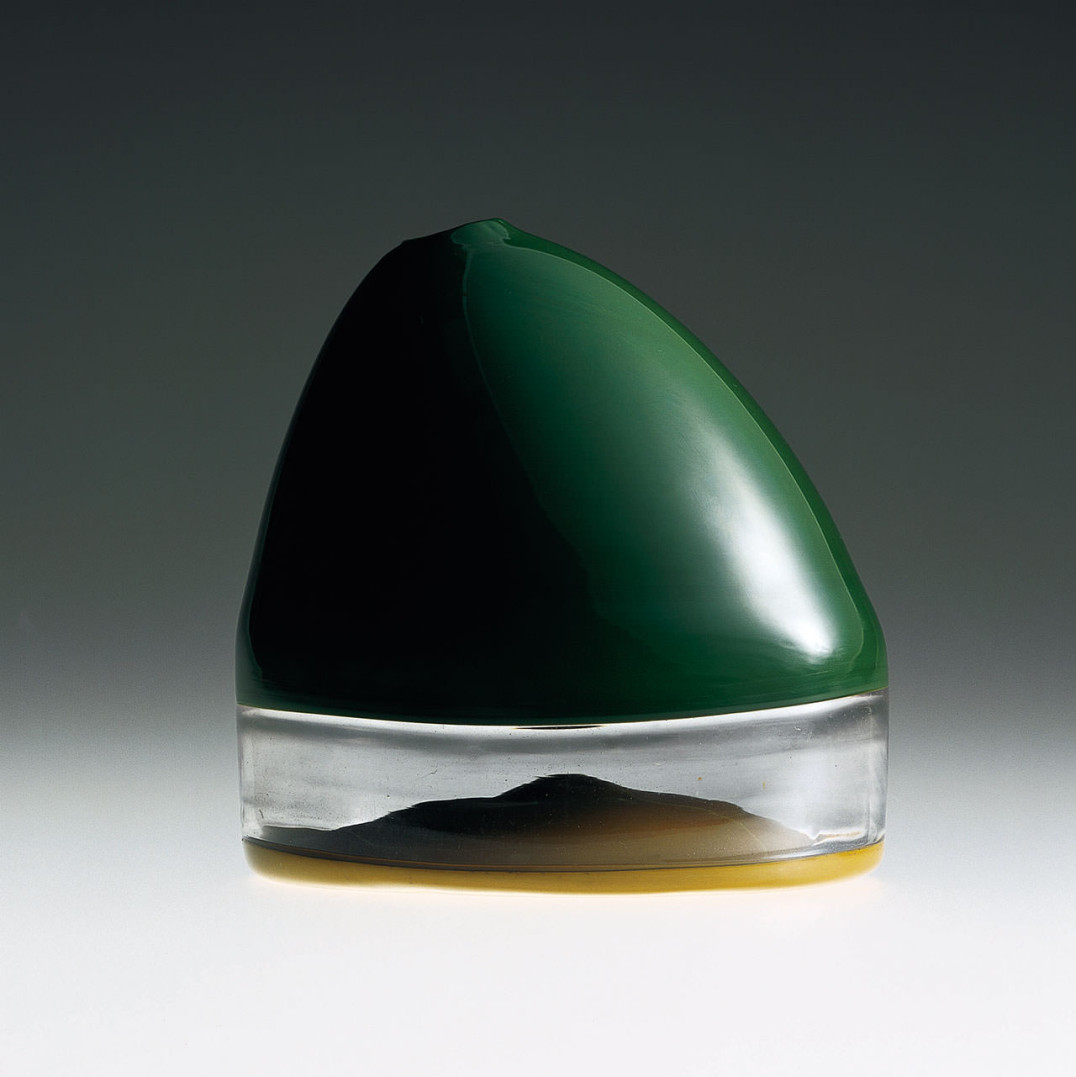
Thomas StearnsCappello del Doge, 1962
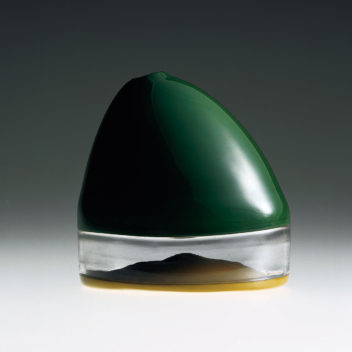
Thomas StearnsCappello del DogeVenini & C., 1962
An asymmetrical vessel obtained with the technique of the double incalmo. Made with yellow pasta vitrea, cristallo, and green pasta vitrea glass. Strongly iridized surface.
Acid stamped:
venini murano ITALIA.
5 1/2 in. high (14 cm)
Exhibitions:
1962, Venice, 31st Biennale Internazionale d’Arte;
2000, New York, Venetian Glass, Museum of Arts & Design;
2001, Milan, Murano: Vetri dalla Collezione Olnick Spanu, Spazio Oberdan.
Bibliography and comparative texts:
Domus, January, 1962, p. 38;
Domus, July, 1963, p. 40;
F. Deboni, 1989, n. 170;
R. Barovier Mentasti, 1992, n. 141;
M. Barovier, R. Barovier Mentasti,
A. Dorigato, 1995, n. 149;
Venezia e la Biennale…, 1995, n. 567;
F. Deboni, 1996, n. 227;
A. Venini Diaz de Santillana, 1996, n. 223;
M. Heiremans, 1996, n. 202;
H. Ricke, E. Schmitt, 1996, n. 158;
A. Venini Diaz de Santillana, 2000, n. 187;
Olnick Spanu, 2000, n. 141;
Olnick Spanu, 2001, n. 178;
A. Dorigato, 2002, p. 345.

Thomas Stearns 1936–2006
Thomas Stearns was born in the United States on September 4, 1936, in Oklahoma City. From 1955 to 1957, he left his hometown to study painting at the Memphis Academy of Art. Between 1957 and 1959 he attended the prestigious Cranbrook Academy of Art and received a postgraduate Fulbright Travel Grant for Italy. He was 24 years old when he arrived at Venini. He started working after Christmas 1959 and stayed with the firm all of 1960 as well as 1961. He left Venice at the end of November 1962, and shortly thereafter the Victoria & Albert Museum in London ordered a group of his works produced by Venini. In 1964, he had his first exhibition of sculpture at the Willard Gallery in New York. In 1965, he was awarded a Guggenheim Fellowship for Sculpture and a grant from the National Institute of Arts and Letters. In 1968, he had a one-man show called Constructions at the Ringling Museum of Art in Sarasota, Florida. In 1970, Stearns began teaching at the University of the Arts, Philadelphia, where he was an associate professor in the sculpture department.

Venini & C. 1932–2001
In 1932, when both Martinuzzi and Zecchin left the company, Paolo Venini changed the name from Vetri Soffiati Muranesi Venini & Co. (V.S.M. Venini & Co.) to Venini & C.. Milanese architect Tommaso Buzzi became the new artistic director. After 1934, artistic direction was taken on by Carlo Scarpa, who designed most of the company's production through 1947. Side by side with Venini, who often intervened personally in design, Scarpa created numerous collections of objects characterized by refined colors. After World War II, Venini & C. sought numerous collaborations with artists such as architect Giò Ponti and the Swedish-born Tyra Lundgren. After 1948, Fulvio Bianconi, Massimo Vignelli, and Tobia Scarpa contributed significantly to the new direction of the company. Paolo Venini died in 1959 and his son-in-law, Ludovico Diaz de Santillana, took over the management of Venini & C. He not only worked personally as a glass designer but also continued the collaboration started by Paolo Venini with various artists and designers. Starting in 1960, many other designers collaborated with the company, like Thomas Stearns, Toni Zuccheri, Tapio Wirkkala, Laura and Alessandro Diaz de Santillana, James Carpenter, Dan Dailey, Richard Marquis, Benjamin Moore, and Toots Zynsky. In 1986, the de Santillana family left the company, selling their stock to the Ferruzzi group, which guaranteed the fine quality Venini was known for by hiring new designers such as Timo Sarpaneva, Marco Zanini, Ettore Sottsass Jr., Alessandro Mendini, Mario Bellini, Barbara del Vicario, and others. In 1988, Venini was acquired by Royal Scandinavian. Since 2001, Venini S.p.A. has been part of Italian Luxury Industries Group and is led by Giancarlo Chimento, Giuliano Tabacchi, and Giorgio Rizzo.
Thomas StearnsCappello del Doge, 1962
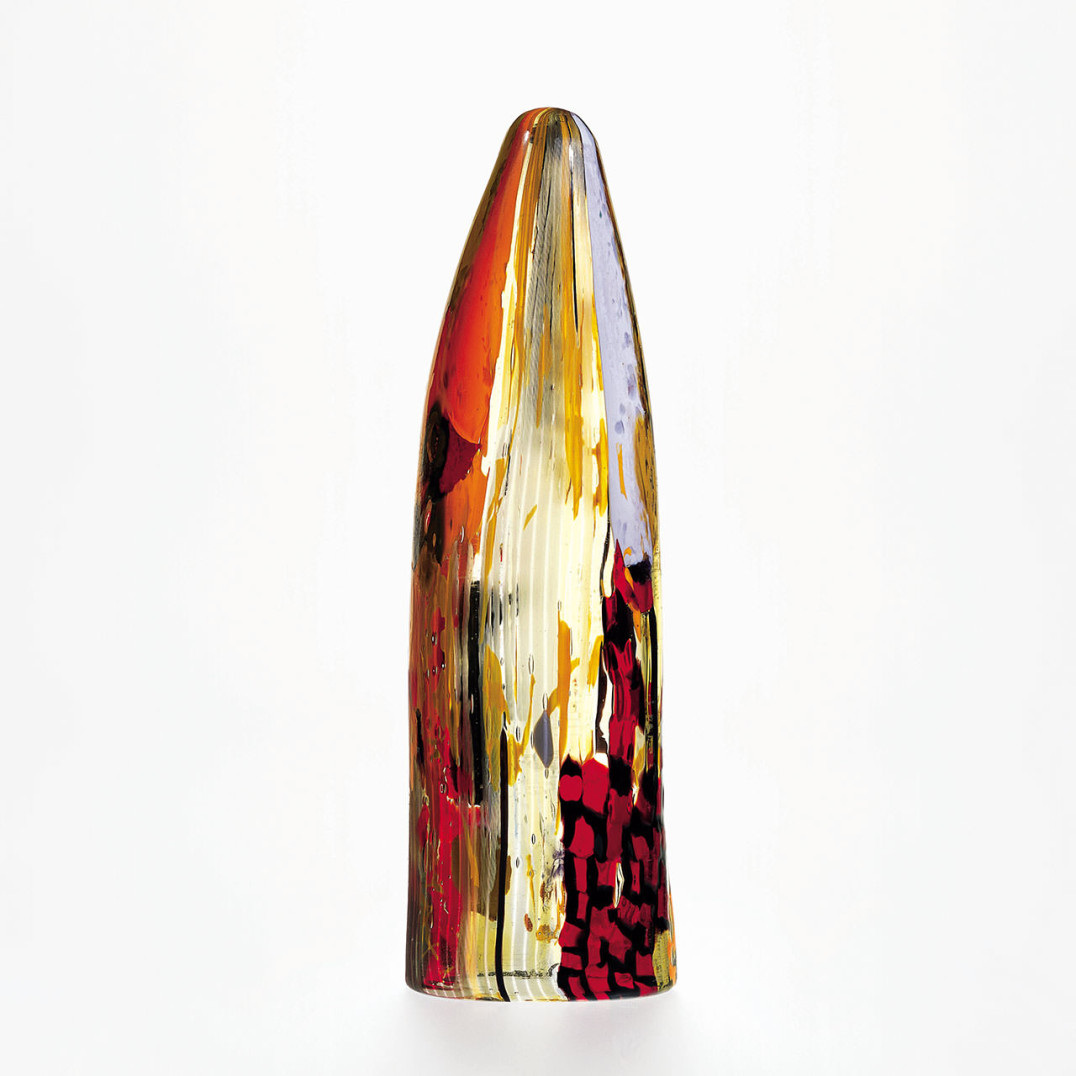
Thomas StearnsLa sentinella di Venezia, 1962

Thomas StearnsLa sentinella di VeneziaVenini & C., 1962
Multicolored glass sculpture composed of iridescent glass canes, murrine and vertical inciso work. One of three made. One was destroyed. Only two remain.
Engraved: 62 Venini Sentinella di Venezia version # 1.
20 7/16 in. high (52 cm)
Exhibitions:
1962, Venice, 31st Biennale Internazionale d’Arte;
2000, New York, Venetian Glass, Museum of Arts & Design;
2001, Milan, Murano: Vetri dalla Collezione Olnick Spanu, Spazio Oberdan.
Bibliography and comparative texts:
M. Karasik, 1989, n. 55;
Olnick Spanu, 2000, n. 140;
Olnick Spanu, 2001, n. 177.

Thomas Stearns 1936–2006
Thomas Stearns was born in the United States on September 4, 1936, in Oklahoma City. From 1955 to 1957, he left his hometown to study painting at the Memphis Academy of Art. Between 1957 and 1959 he attended the prestigious Cranbrook Academy of Art and received a postgraduate Fulbright Travel Grant for Italy. He was 24 years old when he arrived at Venini. He started working after Christmas 1959 and stayed with the firm all of 1960 as well as 1961. He left Venice at the end of November 1962, and shortly thereafter the Victoria & Albert Museum in London ordered a group of his works produced by Venini. In 1964, he had his first exhibition of sculpture at the Willard Gallery in New York. In 1965, he was awarded a Guggenheim Fellowship for Sculpture and a grant from the National Institute of Arts and Letters. In 1968, he had a one-man show called Constructions at the Ringling Museum of Art in Sarasota, Florida. In 1970, Stearns began teaching at the University of the Arts, Philadelphia, where he was an associate professor in the sculpture department.

Venini & C. 1932–2001
In 1932, when both Martinuzzi and Zecchin left the company, Paolo Venini changed the name from Vetri Soffiati Muranesi Venini & Co. (V.S.M. Venini & Co.) to Venini & C.. Milanese architect Tommaso Buzzi became the new artistic director. After 1934, artistic direction was taken on by Carlo Scarpa, who designed most of the company's production through 1947. Side by side with Venini, who often intervened personally in design, Scarpa created numerous collections of objects characterized by refined colors. After World War II, Venini & C. sought numerous collaborations with artists such as architect Giò Ponti and the Swedish-born Tyra Lundgren. After 1948, Fulvio Bianconi, Massimo Vignelli, and Tobia Scarpa contributed significantly to the new direction of the company. Paolo Venini died in 1959 and his son-in-law, Ludovico Diaz de Santillana, took over the management of Venini & C. He not only worked personally as a glass designer but also continued the collaboration started by Paolo Venini with various artists and designers. Starting in 1960, many other designers collaborated with the company, like Thomas Stearns, Toni Zuccheri, Tapio Wirkkala, Laura and Alessandro Diaz de Santillana, James Carpenter, Dan Dailey, Richard Marquis, Benjamin Moore, and Toots Zynsky. In 1986, the de Santillana family left the company, selling their stock to the Ferruzzi group, which guaranteed the fine quality Venini was known for by hiring new designers such as Timo Sarpaneva, Marco Zanini, Ettore Sottsass Jr., Alessandro Mendini, Mario Bellini, Barbara del Vicario, and others. In 1988, Venini was acquired by Royal Scandinavian. Since 2001, Venini S.p.A. has been part of Italian Luxury Industries Group and is led by Giancarlo Chimento, Giuliano Tabacchi, and Giorgio Rizzo.
Thomas StearnsLa sentinella di Venezia, 1962
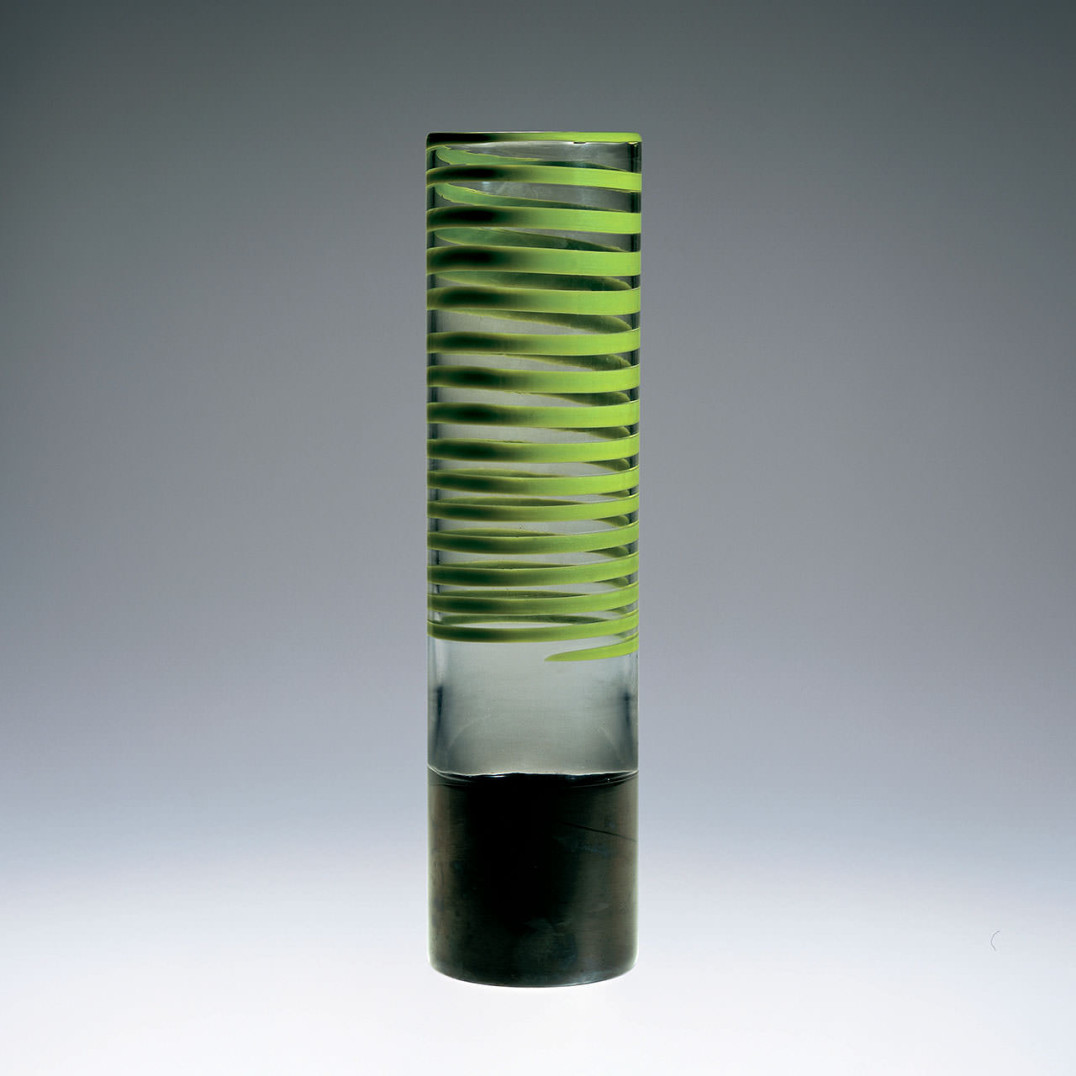
Thomas StearnsSpiralato (Thomas), 1961
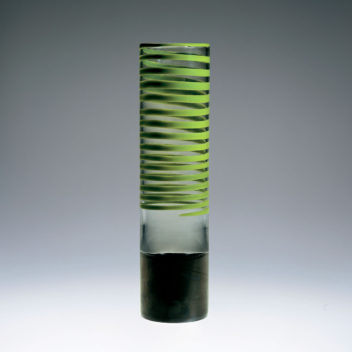
Thomas StearnsSpiralato (Thomas)Venini & C., 1961
Vase obtained with the incalmo technique. The lower part is made of black glass and the top portion is made in cristallo glass with an applied spiral of green glass.
Acid stamped:
venini murano ITALIA.
15 1/8 in. high (38.7 cm)
Exhibitions:
1962, Venice, 31st Biennale Internazionale d’Arte;
2001, Milan, Murano: Vetri dalla Collezione Olnick Spanu, Spazio Oberdan.
Bibliography and comparative texts:
Venini, red catalogue, n. 8631;
Domus, 1962, November, advertising pamphlet;
The Venetians…, p. 48;
F. Deboni, 1989, n. 171;
M. Heiremans, 1993, n. 244;
F. Deboni, 1996, n. 229;
M. Heiremans, 1996, n. 207;
A. Bettagno, 1996, n. 222;
Venini Venezia…, p. 75;
M. Barovier, 1999, p. 267;
Venini, catalogue…, n. 189;
Olnick Spanu, 2001, n. 176;
A. Dorigato, 2002, p. 345.

Thomas Stearns 1936–2006
Thomas Stearns was born in the United States on September 4, 1936, in Oklahoma City. From 1955 to 1957, he left his hometown to study painting at the Memphis Academy of Art. Between 1957 and 1959 he attended the prestigious Cranbrook Academy of Art and received a postgraduate Fulbright Travel Grant for Italy. He was 24 years old when he arrived at Venini. He started working after Christmas 1959 and stayed with the firm all of 1960 as well as 1961. He left Venice at the end of November 1962, and shortly thereafter the Victoria & Albert Museum in London ordered a group of his works produced by Venini. In 1964, he had his first exhibition of sculpture at the Willard Gallery in New York. In 1965, he was awarded a Guggenheim Fellowship for Sculpture and a grant from the National Institute of Arts and Letters. In 1968, he had a one-man show called Constructions at the Ringling Museum of Art in Sarasota, Florida. In 1970, Stearns began teaching at the University of the Arts, Philadelphia, where he was an associate professor in the sculpture department.

Venini & C. 1932–2001
In 1932, when both Martinuzzi and Zecchin left the company, Paolo Venini changed the name from Vetri Soffiati Muranesi Venini & Co. (V.S.M. Venini & Co.) to Venini & C.. Milanese architect Tommaso Buzzi became the new artistic director. After 1934, artistic direction was taken on by Carlo Scarpa, who designed most of the company's production through 1947. Side by side with Venini, who often intervened personally in design, Scarpa created numerous collections of objects characterized by refined colors. After World War II, Venini & C. sought numerous collaborations with artists such as architect Giò Ponti and the Swedish-born Tyra Lundgren. After 1948, Fulvio Bianconi, Massimo Vignelli, and Tobia Scarpa contributed significantly to the new direction of the company. Paolo Venini died in 1959 and his son-in-law, Ludovico Diaz de Santillana, took over the management of Venini & C. He not only worked personally as a glass designer but also continued the collaboration started by Paolo Venini with various artists and designers. Starting in 1960, many other designers collaborated with the company, like Thomas Stearns, Toni Zuccheri, Tapio Wirkkala, Laura and Alessandro Diaz de Santillana, James Carpenter, Dan Dailey, Richard Marquis, Benjamin Moore, and Toots Zynsky. In 1986, the de Santillana family left the company, selling their stock to the Ferruzzi group, which guaranteed the fine quality Venini was known for by hiring new designers such as Timo Sarpaneva, Marco Zanini, Ettore Sottsass Jr., Alessandro Mendini, Mario Bellini, Barbara del Vicario, and others. In 1988, Venini was acquired by Royal Scandinavian. Since 2001, Venini S.p.A. has been part of Italian Luxury Industries Group and is led by Giancarlo Chimento, Giuliano Tabacchi, and Giorgio Rizzo.